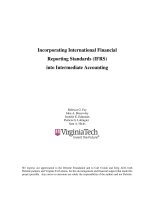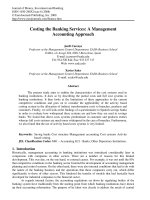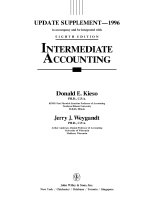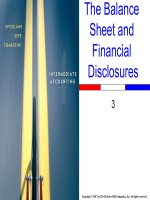Intermediate Accounting - Chap011 potx
Bạn đang xem bản rút gọn của tài liệu. Xem và tải ngay bản đầy đủ của tài liệu tại đây (1.41 MB, 88 trang )
Copyright © 2007 by The McGraw-Hill Companies, Inc. All rights reserved.
Operational
Assets:
Utilization and
Impairment
11
Insert Book Cover
Picture
11-2
Learning Objectives
Explain the concept of cost allocation as it
pertains to operational assets.
11-3
Some of the cost is expensed each period.
Some of the cost is expensed each period.
Cost Allocation – An Overview
Expense
Expense
Acquisition
Cost
Acquisition
Cost
(Balance Sheet) (Income Statement)
The matching principle requires that part of
the acquisition cost of operational assets be
expensed in periods when the future
revenues are earned.
The matching principle requires that part of
the acquisition cost of operational assets be
expensed in periods when the future
revenues are earned.
11-4
Cost Allocation – An Overview
Some of the cost is expensed each period.
Some of the cost is expensed each period.
Expense
Expense
Acquisition
Cost
Acquisition
Cost
(Balance Sheet) (Income Statement)
Depreciation, depletion, and amortization
are cost allocation processes used to help
meet the matching principle requirements.
Depreciation, depletion, and amortization
are cost allocation processes used to help
meet the matching principle requirements.
11-5
Type of
Operational
Asset Debit
Intangible
Amortization
Intangible Asset
Account Credited
Accumulated
Depreciation
Property, Plant, &
Equipment
Depreciation
Natural Resource
Depletion
Natural Resource
Asset
Caution!
Depreciation, depletion, and amortization are
processes of cost allocation, not valuation!
Cost Allocation – An Overview
11-6
Cost allocation requires three pieces of
information for each asset:
The estimated expected
use from an asset.
The estimated expected
use from an asset.
Total amount of cost to be allocated.
Cost - Residual Value (at end of useful life)
Total amount of cost to be allocated.
Cost - Residual Value (at end of useful life)
The systematic approach
used for allocation.
The systematic approach
used for allocation.
Allocation
Base
Allocation
Base
Service
Life
Service
Life
Allocation
Method
Allocation
Method
Measuring Cost Allocation
11-7
Learning Objectives
Determine periodic depreciation using both
time-based and activity-based methods.
11-8
Time-based Methods
Straight-line (SL)
Accelerated Methods
Sum-of-the-years’ digits (SYD)
Declining Balance (DB)
Time-based Methods
Straight-line (SL)
Accelerated Methods
Sum-of-the-years’ digits (SYD)
Declining Balance (DB)
Activity-based methods
Units-of-production method (UOP).
Activity-based methods
Units-of-production method (UOP).
Group and
composite
methods
Group and
composite
methods
Tax
depreciation
Tax
depreciation
Depreciation of Operational Assets
11-9
Depreciation on the Balance Sheet
Net property, plant & equipment is the
undepreciated cost (book value) of plant assets.
11-10
Straight-Line
The most widely
used and most
easily understood
method.
The most widely
used and most
easily understood
method.
Results in the same
amount of depreciation
in each year of the
asset’s service life.
Results in the same
amount of depreciation
in each year of the
asset’s service life.
11-11
On January 1, we purchase equipment for
$50,000 cash. The equipment has an
estimated service life of 5 years and
estimated residual value of $5,000.
What is the annual straight-line
depreciation?
On January 1, we purchase equipment for
$50,000 cash. The equipment has an
estimated service life of 5 years and
estimated residual value of $5,000.
What is the annual straight-line
depreciation?
Straight-Line
11-12
Straight-Line
11-13
Accumulated Accumulated Undepreciated
Depreciation Depreciation Depreciation Balance
Year (debit) (credit) Balance (book value)
50,000$
1 9,000$ 9,000$ 9,000$ 41,000
2 9,000 9,000 18,000 32,000
3 9,000 9,000 27,000 23,000
4 9,000 9,000 36,000 14,000
5 9,000 9,000 45,000 5,000
45,000$ 45,000$
Residual Value
Residual Value
Note that at the end of the asset’s
useful life, BV = Residual Value
Note that at the end of the asset’s
useful life, BV = Residual Value
Straight-Line
11-14
0
1000
2000
3000
4000
5000
6000
7000
8000
9000
1 2 3 4 5
Life in Years
Depreciation
Straight-Line
11-15
Accelerated methods result in more
depreciation in the early years of an
asset’s useful life and less depreciation
in later years of an asset’s useful life.
Accelerated methods result in more
depreciation in the early years of an
asset’s useful life and less depreciation
in later years of an asset’s useful life.
Accelerated Methods
Note that total
depreciation over the
asset’s useful life is the
same as the Straight-
line Method.
Note that total
depreciation over the
asset’s useful life is the
same as the Straight-
line Method.
11-16
2
SYD depreciation is computed as follows:
Sum-of-the-Years’ Digits (SYD)
11-17
On January 1, we purchase equipment for
$50,000 cash. The equipment has a
service life of 5 years and an estimated
residual value of $5,000.
Using SYD, compute depreciation
for the first two years.
On January 1, we purchase equipment for
$50,000 cash. The equipment has a
service life of 5 years and an estimated
residual value of $5,000.
Using SYD, compute depreciation
for the first two years.
Sum-of-the-Years’-Digits (SYD)
11-18
2
Use this in your computation of SYD
Depreciation for Years 1 & 2.
Use this in your computation of SYD
Depreciation for Years 1 & 2.
Sum-of-the-Years’ Digits (SYD)
11-19
Sum-of-the-Years’ Digits (SYD)
11-20
Accumulated Undepreciated
Depreciation Depreciation Balance
Fraction (debit) Balance (book value)
50,000$
5/15 15,000$ 15,000$ 35,000
4/15 12,000 27,000 23,000
3/15 9,000 36,000 14,000
2/15 6,000 42,000 8,000
1/15 3,000 45,000 5,000
45,000$
Accumulated Undepreciated
Depreciation Depreciation Balance
Fraction (debit) Balance (book value)
50,000$
5/15 15,000$ 15,000$ 35,000
4/15 12,000 27,000 23,000
3/15 9,000 36,000 14,000
2/15 6,000 42,000 8,000
1/15 3,000 45,000 5,000
45,000$
Residual Value
Residual Value
Sum-of-the-Years’ Digits (SYD)
11-21
0
2000
4000
6000
8000
10000
12000
14000
16000
1 2 3 4 5
Life in Years
Depreciation
Sum-of-the-Years’ Digits (SYD)
11-22
Declining-Balance (DB) Methods
DB depreciation
Based on the straight-line
rate multiplied by an
acceleration factor.
Computations initially ignore
residual value.
DB depreciation
Based on the straight-line
rate multiplied by an
acceleration factor.
Computations initially ignore
residual value.
Stop depreciating
when:
BV=Residual Value
Stop depreciating
when:
BV=Residual Value
11-23
DDB depreciation is computed as follows:
Note that the Book Value
will get lower each time
depreciation is computed!
Note that the Book Value
will get lower each time
depreciation is computed!
Double-Declining-Balance (DDB)
11-24
On January 1, we purchase equipment for $50,000
cash. The equipment has a service life of 5 years
and an estimated residual value of $5,000.
What is depreciation for
the first two years using
double-declining-balance?
On January 1, we purchase equipment for $50,000
cash. The equipment has a service life of 5 years
and an estimated residual value of $5,000.
What is depreciation for
the first two years using
double-declining-balance?
Double-Declining-Balance (DDB)
11-25
Double-Declining-Balance (DDB)









